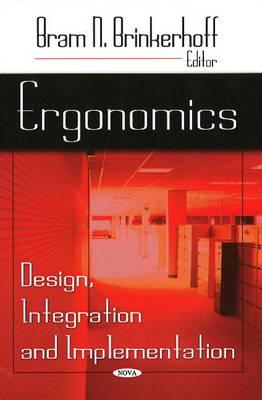
Ergonomics: Design, Integration and Implementation
Hardcover
Medical ReferenceTechnology & EngineeringGeneral Architecture
Currently unavailable to order
Please enter your email and a message will be sent to you when this product becomes available on our website.
ISBN13: 9781606923276
Publisher: Nova Science Pub Inc
Published: Jan 1 2009
Pages: 288
Weight: 1.55
Height: 0.90 Width: 10.20 Depth: 7.10
Language: English
Also in
General Architecture
Critical Prison Design: Mas d'Enric Penitentiary by Aib Arquitectes + Estudi PSP Arquitectura
Paez, Roger
Paperback
Code Check Plumbing & Mechanical 6th Edition: An Illustrated Guide to the Plumbing & Mechanical Codes
Hansen, Douglas
Walker, Skip
Kardon, Redwood
Paperback
A Natural History of Empty Lots: Field Notes from Urban Edgelands, Back Alleys, and Other Wild Places
Brown, Christopher
Hardcover
The Well-Designed Accessory Dwelling Unit: Fitting Great Architecture Into Small Spaces
Lee, Lydia
Hardcover
Engineering in Plain Sight: An Illustrated Field Guide to the Constructed Environment
Hillhouse, Grady
Hardcover
Drawing Codes: Experimental Protocols of Architectural Representation
Kudless, Andrew
Marcus, Adam
Hardcover
A House Needs to Breathe...Or Does It?: An Introduction to Building Science
Bailes, Allison A., III
Hardcover
Into the Quiet and the Light: Water, Life, and Land Loss in South Louisiana
Hanusik, Virginia
Hardcover
Cheap Old Houses: An Unconventional Guide to Loving and Restoring a Forgotten Home
Finkelstein, Ethan
Finkelstein, Elizabeth
Hardcover
Meet Me at the Library: A Place to Foster Social Connection and Promote Democracy
Hallman, Shamichael
Paperback
Walkable City: How Downtown Can Save America, One Step at a Time (Tenth Anniversary Edition)
Speck, Jeff
Paperback
A Field Guide to American Houses (Revised): The Definitive Guide to Identifying and Understanding America's Domestic Architecture
McAlester, Virginia Savage
Paperback
The Last Castle: The Epic Story of Love, Loss, and American Royalty in the Nation's Largest Home
Kiernan, Denise
Paperback
Housesketching: Learn to Create Energetic and Expressive Architectural Drawings
Kiefer, Albert
Paperback
Shrink the City: The 15-Minute Urban Experiment and the Cities of the Future
Whittle, Natalie
Paperback
Palaces for the People: How Social Infrastructure Can Help Fight Inequality, Polarization, and the Decline of Civic Life
Klinenberg, Eric
Paperback
Cómo calcular un presupuesto de obra desde cero: El análisis de precios unitarios aplicado a los costos en la construcción
Hidalgo P., Carlos
Paperback
Get Your House Right: Architectural Elements to Use & Avoid
Sammons, Richard
Cusato, Marianne
Pentreath, Ben
Paperback
A Paradise of Small Houses: The Evolution, Devolution, and Potential Rebirth of Urban Housing
Podemski, Max
Hardcover
London, Block by Block: An Illustrated Guide to the Best of England's Capital
Block, Cierra
Hardcover
Restoring Notre-Dame de Paris: Rebirth of the Legendary Gothic Cathedral
de Chalus, Olivier
Zachmann, Patrick
Hardcover
The 99% Invisible City: A Field Guide to the Hidden World of Everyday Design
Kohlstedt, Kurt
Mars, Roman
Hardcover
101 Things I Didn't Learn In Architecture School: And wish I had known before my first job
Lebner, Sarah
Paperback
Mini-Forest Revolution: Using the Miyawaki Method to Rapidly Rewild the World
Lewis, Hannah
Paperback
Measure and Construction of the Japanese House: 250 Plans and Sketches Plus Illustrations of Joinery
Engel, Heino
Hardcover
Polyface Designs: A Comprehensive Construction Guide for Scalable Farming Infrastructure
Slattery, Chris
Salatin, Joel
Paperback
Geography of Nowhere: The Rise and Declineof America's Man-Made Landscape
Kunstler, James Howard
Paperback
Code Check Complete 3rd Edition: An Illustrated Guide to the Building, Plumbing, Mechanical, and Electrical Codes
Kardon, Redwood
Hansen, Douglas
Paperback
Nature, Garden and Forest: Colouring Books for Adults with Tear Out Sheets
Wonder House Books
Paperback
Building for People: Designing Livable, Affordable, Low-Carbon Communities
Eliason, Michael
Paperback
Key West Cottages and Gardens: Inspiration from America's Special Tropical Island
Linsley, Leslie
Hardcover
Henry Hobson Richardson: Drawings from the Collection of Houghton Library, Harvard University
Milford, Chris
Wickersham, Jay
Mayo, Hope
Hardcover
A British Country House Alphabet: A Historical and Pictorial Journey Volume 1
DiCamillo, Curt
Hardcover
Blood sugar logbook: Large print diabetic diary for glucose level monitoring & Tracking (Large Print Edition)
Charles, Emma
Paperback
Find the Lost Dollars: 6 Steps to Increase Profits in Architecture, Engineering and Environmental Firms - Abridged Version
Jewell, June R.
Paperback
Architecture Reference & Specification Book Updated & Revised: Everything Architects Need to Know Every Day (Revised)
McMorrough, Julia
Paperback
A City Built By Giants: The Architectural Masters That Shaped Buffalo, New York
Clark, Austin R.
Donnelly, Mark D.
Hardcover
Beauty, Neuroscience, and Architecture: Timeless Patterns and Their Impact on Our Well-Being
Ruggles, Donald H.
Hardcover
Shelters, Shacks, and Shanties: A Guide to Building Shelters in the Wilderness
Beard, D. C.
Hardcover
Turf War: How a Band of Activists Saved New York from Donald Trump's "Masterpiece"
Robinson, Steven
Paperback


 Sign-In
Sign-In Cart
Cart